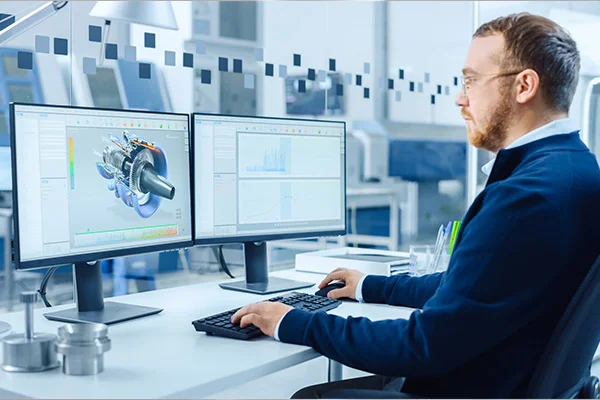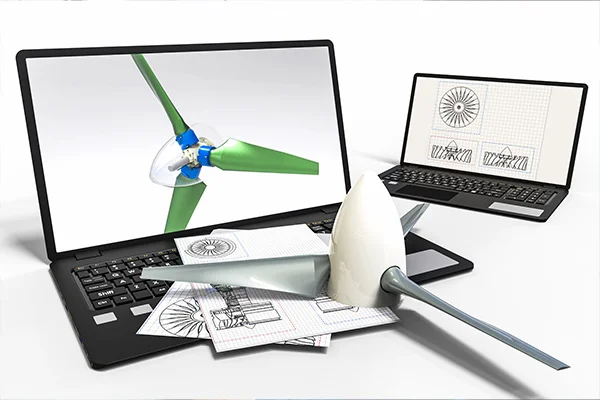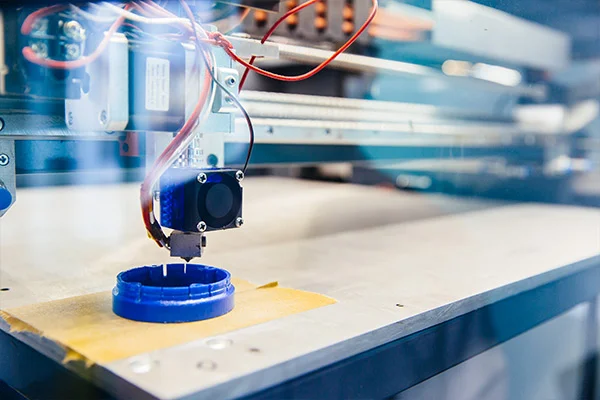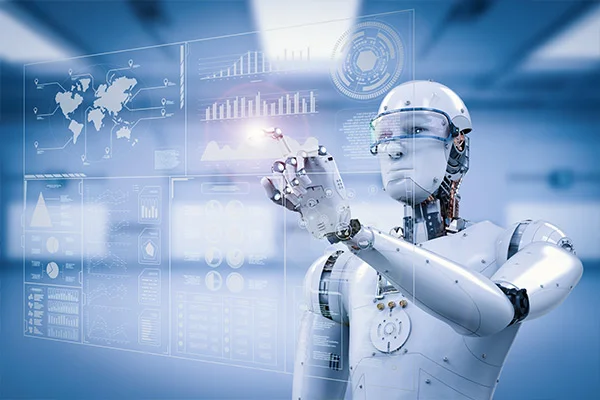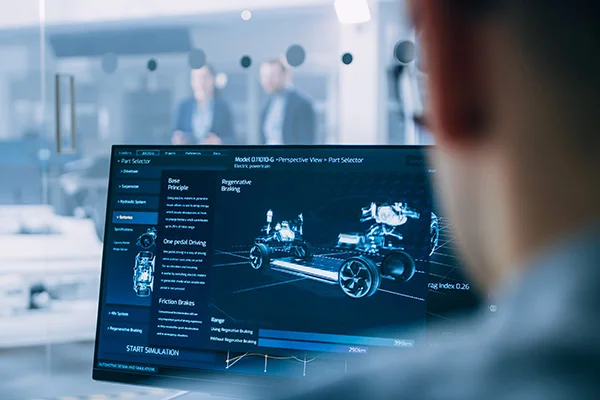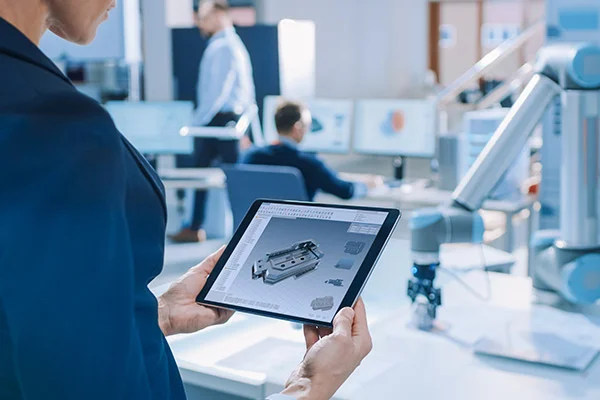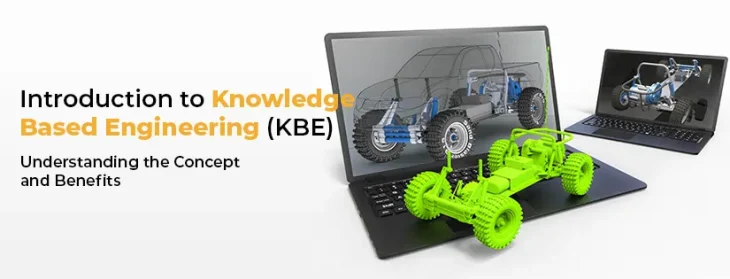Optimization Strategies in Knowledge-Based Engineering for Manufacturing Processes
Table of content The Evolution of Knowledge-Based Engineering The Importance of Optimization in Manufacturing Optimization Strategies in Knowledge-Based Engineering 1. Design Exploration and Parametric Optimization2. Generative Design3. Process Optimization4. Multi-Objective Optimization5. Knowledge-Based Decision Support Applications of Optimization in Knowledge-Based Engineering 1. Aerospace Industry2. Automotive Manufacturing3. Pharmaceutical Manufacturing4. Sustainable Manufacturing5. Consumer Electronics Future Trends and Challenges Conclusion Manufacturing processes have undergone significant transformations in recent years, emphasizing efficiency, precision, and cost-effectiveness. Knowledge-Based Engineering (KBE) has emerged as a crucial framework that combines engineering knowledge with computational tools to streamline the design and manufacturing processes. This article will explore the optimization strategies employed in Knowledge-Based Engineering for manufacturing processes, highlighting their importance, applications, and future potential. The Evolution of Knowledge-Based Engineering Before delving into optimization strategies, it’s essential to understand the evolution of Knowledge-Based Engineering and its role in manufacturing. KBE is a discipline that integrates knowledge from various domains, including engineering, materials science, and manufacturing, into a digital framework. This framework allows engineers and designers to leverage existing knowledge and expertise to expedite product development and enhance manufacturing processes. The roots of KBE can be traced back to Artificial Intelligence (AI) and Expert Systems, which aimed to replicate human expertise in solving complex problems. Over time, KBE has evolved to incorporate advanced techniques such as machine learning, knowledge representation, and optimization algorithms. This evolution has paved the way for KBE to play a pivotal role in modern manufacturing. The Importance of Optimization in Manufacturing Optimization lies at the heart of efficient and cost-effective manufacturing processes. It involves finding the best combination of parameters or variables to achieve specific goals while minimizing costs or maximizing performance. In manufacturing, optimization can address various challenges, including: Read More: India’s Growing Video Surveillance Market Optimization Strategies in Knowledge-Based Engineering Knowledge-based engineering employs various optimization strategies to address the challenges mentioned above. These strategies harness the power of data, knowledge, and advanced algorithms to drive efficiency and innovation in manufacturing processes. Here are some key optimization strategies used in KBE: 1. Design Exploration and Parametric Optimization KBE systems enable engineers to explore a wide range of design alternatives quickly. By defining design parameters and constraints, engineers can use optimization algorithms to find the best design that meets predefined objectives. This approach not only accelerates the design process but also ensures that the final product is optimized for performance, cost, and manufacturability. 2. Generative Design Generative design is an advanced optimization technique that leverages AI and computational algorithms to generate innovative design solutions. Engineers input design goals and constraints, and the generative design software explores countless possibilities, often coming up with unconventional and highly efficient designs that human designers may not have considered. 3. Process Optimization Manufacturing processes often involve intricate workflows with multiple variables. KBE systems use optimization algorithms to fine-tune these processes by adjusting parameters such as temperature, pressure, and feed rates. This improves process efficiency, reduces energy consumption, and minimizes waste. 4. Multi-Objective Optimization In many manufacturing scenarios, multiple conflicting objectives must be considered simultaneously. Multi-objective optimization algorithms enable engineers to find solutions that balance these objectives. For example, manufacturers may want to minimize production costs while maximizing product quality and sustainability. KBE can help identify the best compromise among these objectives. 5. Knowledge-Based Decision Support KBE systems integrate expert knowledge and best practices into decision support tools. This knowledge can guide engineers and designers in making informed decisions throughout the product development and manufacturing processes. By providing access to a wealth of expertise, KBE enhances decision-making and leads to optimized outcomes. Applications of Optimization in Knowledge-Based Engineering The applications of optimization in Knowledge-Based Engineering for manufacturing processes are diverse and impactful. Let’s explore some real-world examples: 1. Aerospace Industry In the aerospace industry, where safety and performance are paramount, KBE systems are used to optimize aircraft design, engine performance, and manufacturing processes. Parametric optimization ensures that aircraft components are lightweight, fuel-efficient, and aerodynamically sound. 2. Automotive Manufacturing Automotive manufacturers employ KBE for vehicle design and production optimization. Generative design techniques help create lightweight yet structurally robust components, while process optimization minimizes assembly line bottlenecks and reduces production costs. 3. Pharmaceutical Manufacturing Pharmaceutical companies use KBE to optimize drug formulation processes, ensuring the consistent quality and efficacy of medications. Multi-objective optimization balances production costs, regulatory compliance, and product quality. 4. Sustainable Manufacturing Optimization plays a pivotal role in achieving sustainability goals. For example, in the paper and pulp industry, KBE is used to optimize resource allocation, reducing energy consumption and minimizing waste. Similarly, in renewable energy sectors, KBE aids in optimizing the design and operation of wind turbines and solar panels for maximum energy production. 5. Consumer Electronics The rapid pace of innovation in the consumer electronics industry demands efficient design and manufacturing processes. KBE tools are used to optimize the form and function of electronic devices while minimizing production costs. Also Read: What is Asset Tracking and What are its Benefits Future Trends and Challenges As technology continues to advance, the field of Knowledge-Based Engineering for manufacturing processes is expected to evolve further. Here are some future trends and challenges to watch for: Conclusion Knowledge-based engineering has ushered in a new era of optimization in manufacturing processes. By leveraging engineering knowledge, data, and advanced algorithms, KBE systems enable engineers and designers to create more efficient and sustainable products and processes. The future holds even more promise, with AI, digital twins, and sustainability playing pivotal roles in shaping the landscape of manufacturing optimization. As manufacturers continue to embrace KBE, the industry will undoubtedly see further improvements in efficiency, cost-effectiveness, and sustainability, driving innovation and progress in the world of manufacturing. If you’re ready to take your manufacturing processes to the next level with state-of-the-art Knowledge-Based Engineering solutions, consider exploring what Prescient offers. Their expertise in KBE can help you optimize your operations and stay ahead in the competitive manufacturing landscape. Don’t miss the opportunity to transform your manufacturing processes with Prescient’s cutting-edge solutions.
Read More5 Ways Knowledge-Based Engineering (KBE) Can Streamline Product Development
Table of content Introduction 5 Effective Strategies to Streamline Product Development Through KBE Conclusion Introduction Companies always look for ways to enhance efficiency and optimize product development processes. Knowledge-based engineering helps manufacturing companies boost overall performance in today’s dynamic, technology-driven environment. It automates design, analysis, and decision-making by fusing engineering expertise with cutting-edge computational techniques. This article will examine five crucial ways of knowledge-based engineering that can speed up product development. Increased productivity, lower costs, and shorter time to market are the standout benefits of incorporating this technology. 5 Effective Strategies to Streamline Product Development Through KBE: Are you looking to streamline your product development process? Discover how Knowledge-based engineering (KBE) can revolutionize your approach with these five key strategies: Automated Design and Optimization One of the primary benefits of knowledge-based engineering is its ability to automate the design process. It captures and encodes engineering knowledge into rule-based systems to generate designs following predefined constraints and requirements. It eliminates repetitive manual design iterations, significantly reduces human error, and accelerates the entire process. You can leverage parametric modeling techniques to create design templates with adjustable parameters. These templates serve as the starting point for generating multiple design alternatives. Engineers can modify the parameters for the KBE system to adjust the design automatically. This iterative process encourages rapid exploration of design options without requiring manual modifications at each step. Additionally, the system integrates optimization algorithms to explore design spaces and identify optimal solutions. The system can define design objectives and constraints to refine the design and achieve the desired performance metrics iteratively. This approach saves, improves product performance, and reduces development time. Standardization and Reusability Knowledge-Based Engineering promotes standardization and reusability of design elements, components, and workflows. Organizations can establish a consistent design methodology across projects, departments, and locations by codifying engineering knowledge into reusable modules. This standardization ensures product quality and allows for the seamless transfer of knowledge between teams. This methodology accelerates the development process. Using KBE systems, you can create design libraries that act as repositories of verified and improved design solutions. These collections include modular elements, including CAD templates, simulation models, and 3D models. Engineers can use the components from these libraries to speed up and simplify their design processes. Reusing pre-validated components across many projects ensures consistency and dependability. Enhanced Collaboration and Knowledge Sharing Collaboration is crucial in product development, especially in large organizations or projects involving multidisciplinary teams. Knowledge-based engineering provides a platform for engineers from different domains to share and access engineering knowledge. Engineers can collaborate in real-time, exchange design information, and perform concurrent engineering tasks. They can also contribute their expertise to the overall product development process. KBE systems commonly include features like version control, document management, and communication tools. These capabilities assist engineers in collaborating on design projects and accessing the most recent design information. They can also offer their perspectives through this system. Engineers from various specialties like mechanical, electrical, and software engineering can collaborate and work seamlessly. It helps reduce communication gaps and also streamlines decision-making. Furthermore, KBE systems can capture and document the rationale behind design decisions. It helps preserve valuable engineering knowledge to share across the organization. Lessons from previous projects can be stored as design rules, best practices, and simulation models. It allows engineers to build upon existing knowledge. KBE enhances product development processes’ overall efficiency and effectiveness by facilitating knowledge sharing and collaboration. Optimize Performance and Efficiency Efficient design tools must perform at their peak to handle intricate 3D models, big assemblies, and computationally demanding activities. The main goal of CAD software development should be performance optimization. Reduce computing complexity and memory utilization by using algorithms and data structures. Use approaches like spatial indexing, effective mesh representations, and level-of-detail algorithms to ensure quick rendering and easy interaction with the CAD models. Utilize the power of contemporary hardware by using multithreading and parallel processing. You can use several CPU cores and GPUs for quicker computations. The user experience can be further improved through asynchronous processing and background jobs. They can deliver responsive interfaces even during computationally demanding operations. Design Validation and Verification Product development involves numerous design iterations and validation steps to ensure the final product meets the desired performance and safety requirements. Knowledge-based engineering simplifies the design validation and verification processes by directly integrating computational tools and simulations into the design workflow. It can embed engineering rules and simulation models to automatically evaluate design alternatives. It also helps you perform virtual testing and assess the product’s behavior under various operating conditions. KBE systems enable engineers to define design constraints and requirements upfront. These constraints can include factors such as material properties, stress limits, and geometric tolerances. During the design process, the KBE system continuously checks the design against these constraints, providing real-time feedback to the engineers. Instant feedback helps identify design issues early in the development cycle, reducing the risk of costly errors and rework. KBE systems also use simulation models to forecast the product’s performance before building prototypes. The design procedures incorporate finite element analysis (FEA), computational fluid dynamics (CFD), and other simulation methods. Engineers can evaluate structural integrity, thermal behavior, and fluid flow characteristics. There’s less need for physical prototypes, and it saves time and money by doing virtual testing and analysis. Embrace Open Standards and Integration CAD software rarely operates in isolation. It often needs to interact with other software systems and exchange data with external tools. Embrace open standards and interoperability to integrate with commonly used file formats, industry-specific standards, and collaboration platforms. Support file import/export in common formats, including STEP, IGES, and STL, to ensure interoperability with various CAD systems and manufacturing procedures. Create APIs and SDKs that let outside developers add features to your CAD program or incorporate it into broader software ecosystems. Utilize existing libraries and frameworks for performing typical CAD tasks. You can also use it to collaborate with industry groups and communities to maintain current standards. Your CAD solution can benefit from integrating analysis tools, simulation software,
Read MoreKBE Methodology for Product Design and Development
Table of content Introduction The KBE Methodology: An Overview The Benefits of KBE in Product Design and Development Application of KBE in Product Design and Development Challenges and Considerations Overcoming Resistance to Automation The Future of Manufacturing and Vision-Based Inspection Conclusion Introduction Businesses continuously seek ways to enhance their product design and development processes in today’s fast-paced, cutthroat business environment. Knowledge-Based Engineering (KBE) is one methodology that has drawn much interest. KBE streamlines the product development lifecycle and boosts overall effectiveness by combining technical expertise, CAD, and AI approaches. This article investigates the KBE approach, its advantages, and how it might be used to build new products. The KBE Methodology: An Overview Knowledge-Based Engineering (KBE) incorporates knowledge from diverse fields into computer- based systems. Engineers can produce novel items quickly because of the automation of design and engineering procedures made possible by these systems. KBE uses the capabilities of expert systems, rule-based reasoning, and artificial intelligence to capture and apply engineering knowledge over a product’s lifecycle. The Benefits of KBE in Product Design and Development The Knowledge-Based Engineering (KBE) methodology can be adapted to create products with various benefits. KBE enables organisations to accomplish their objectives more quickly and successfully. Let’s explore KBE’s advantages, revolutionising how things are created, developed, and released onto the market. Improved Efficiency and Speed KBE makes it possible to automate time-consuming, repetitive design procedures. Engineers can build designs, run simulations, and assess options fast by utilising pre-existing knowledge and regulations. This quickens the product development process, cutting down on time to market and giving the company a competitive edge. Enhanced Product Quality KBE systems enforce design limitations and regulations, reducing mistake rates and guaranteeing adherence to industry standards. KBE lessens the possibility of design mistakes by integrating technical expertise into the design process, improving the overall quality and dependability of the finished product. Increased Collaboration and Reusability KBE encourages communication and cooperation between engineering teams. All stakeholders will easily access design knowledge once it has been collected and organised in a central repository. This promotes reusability and enables engineers to draw on their prior expertise and successful ideas. Cost Reduction KBE’s automated features reduce manual iterations, reducing labour expenses and associated overhead. KBE aids in avoiding expensive design revisions at later phases of product development by minimising mistakes and optimising design decisions. Further lowering costs is made possible by the reuse of information and design elements. Application of KBE in Product Design and Development There are many opportunities when Knowledge-Based Engineering (KBE) is used in the design and development of products. KBE enables engineers to optimise designs, guarantee compliance with standards, and streamline the overall development workflow by interacting with CAD, simulation, and analytic tools. This section will examine how KBE is revolutionising product design and development by transforming how things are developed, validated, and ready for manufacturing. Conceptual Design KBE provides design templates, rule-based reasoning, and simulation tools to aid in the conceptualisation stage. Under established guidelines and limitations, engineers may quickly investigate potential design solutions, assess their performance, and come to wise conclusions. Detailed Design KBE streamlines the creation of 3D CAD models, automates geometric and parametric modelling, and maintains adherence to design standards during the detailed design process. By taking into account various aspects, including material selection, manufacturability, and assembly requirements, it enables engineers to optimise designs. Simulation and Analysis Vision-based inspection systems can validate proper component alignment and positioning in intricate manufacturing lines. To ensure exact assembly and lower the possibility of defective or out- of-place items, they can compare acquired photos against predetermined templates. Early detection of faults allows producers to avoid problems later on and enhance overall product quality. Design Validation and Verification Engineers can validate designs using KBE systems against industry standards, regulatory requirements, and design specifications. KBE makes sure that products fulfil safety, quality, and performance standards before they move into production by automating compliance inspections. Challenges and Considerations Although vision-based inspection systems have several benefits for production, they are difficult to implement. To achieve successful integration and ideal results, these elements must be addressed. Let’s examine the difficulties and vital elements to consider while implementing vision-based manufacturing inspection. Overcoming Resistance to Automation Although there is no denying the advantages of vision-based inspection systems, some manufacturers could be reluctant to adopt automation due to worries about job loss and up-front expenditures. It is crucial to understand that automation does not always imply the replacement of human labour. Instead, it enables them to concentrate on higher-value duties like inspecting inspection data, streamlining processes, and enhancing quality. Furthermore, long-term cost savings and increased productivity can benefit more than the initial investment in vision-based inspection equipment. When weighing the deployment of these technologies, manufacturers should consider the return on investment (ROI) and potential competitive advantages. The Future of Manufacturing and Vision-Based Inspection Automation is the key to the success of manufacturing in the future, and vision-based inspection is leading this change. These systems will grow more potent, precise, and adaptable as technology develops. The effectiveness and capacities of vision-based inspection in manufacturing will be further improved by integration with other developing technologies, including robotics, the Internet of Things (IoT), and augmented reality. Vision-based inspection technologies will maintain product quality and reduce environmental impact as the industry prioritises sustainability and waste reduction. Manufacturers may reduce waste and help create a more sustainable manufacturing ecosystem by identifying problems early in production. Conclusion The manufacturing sector is changing because vision-based inspection systems offer precise, effective, and reasonably priced quality control solutions. By embracing automation, manufacturers can obtain greater precision, increased efficiency, and lower costs. By utilising AI and machine vision technologies, businesses can streamline processes, enhance product quality, and gain a competitive edge in the global market. Ready to revolutionise your manufacturing processes with the vision-based inspection? Contact Prescient today to unlock the power of automation, accuracy, and efficiency in quality control.
Read MoreRevolutionising Engineering Design: The Role of AI & Machine Learning in KBE
Table of content Introduction Understanding Knowledge-Based Engineering (KBE) AI and Machine Learning in KBE Benefits of AI in KBE Challenges and Considerations Conclusion Introduction One industry where artificial intelligence (AI) has made significant strides is engineering design. With the advancement of machine learning algorithms, AI is redefining how engineers approach design difficulties, leading to more practical and innovative solutions. In this article, we embark on an exciting voyage into knowledge-based engineering (KBE), where artificial intelligence (AI) and machine learning take centre stage. Get ready to see how the field of engineering design is being revolutionised. Prepare yourself as we examine how AI and machine learning algorithms are rewriting the rules, seamlessly automating tedious jobs, and accelerating creativity to unprecedented levels. So, lets us dive in to know more. Understanding Knowledge-Based Engineering (KBE) By using a knowledge-driven system to automate engineering design processes, knowledge-based engineering (KBE) is a methodology. Developing design alternatives, automating design processes, and supporting decision-making depends on capturing and applying expert knowledge. To enhance the design process and boost productivity, KBE systems combine design guidelines, technical expertise, and computer algorithms to enhance the design process and boost productivity. So, let us explore the cutting-edge world where engineering and technology meet to create new possibilities for design. AI and Machine Learning in KBE KBE systems depend heavily on artificial intelligence, especially machine learning, which enables them to learn from data, spot patterns, and make wise decisions. Here are a few ways that AI and machine learning, through KBE, are revolutionising engineering design: Large amounts of data can be analysed using machine learning algorithms to improve designs. AI can produce design choices and choose the best one based on predefined criteria by finding patterns and relationships in data. This saves time and resources by eliminating the need for manual trial and error. A generative design method uses AI algorithms with limitations and goals to generate many design possibilities. Machine learning models can examine existing designs, draw lessons from them, and produce fresh design concepts better suited to specific needs. This creates new opportunities and enables engineers to investigate novel concepts that may not have been considered. KBE can capture and use expert knowledge to automate design processes with AI-powered expert systems. These systems can replicate expert human decision-making and offer advice based on pre-established norms and criteria. Engineers can create more effectively and efficiently thanks to AI, which uses the pooled expertise of specialists. Machine learning algorithms can analyse large datasets to uncover helpful information that might not be visible to human designers. AI can uncover novel design concepts or optimisation techniques that can result in advancements in engineering design by spotting hidden patterns and connections. This improves originality and creativity during the design process. Benefits of AI in KBE Utilise Knowledge-Based Engineering (KBE)’s (amazing) AI capabilities to accelerate your engineering design process. Bid adieu to manual labour and welcome greater productivity, exactitude, cost savings, and a spurt of invention. Let’s explore the fascinating advantages that AI offers KBE: KBE provides design templates, rule-based reasoning, and simulation tools to aid in the conceptualisation stage. Under established guidelines and limitations, engineers may quickly investigate potential design solutions, assess their performance, and come to wise conclusions. AI aids in cost reduction during the design and production phases by optimising designs and decreasing the requirement for physical prototypes. Simulators and virtual testing with AI capabilities can detect possible problems early on, saving time and money. Engineers can explore various design options and push the limits of what is conventionally thought possible thanks to AI-powered generative design. This encourages creativity and creates new engineering design opportunities. Challenges and Considerations Although using AI in Knowledge-Based Engineering (KBE) has many advantages, there are also significant difficulties and factors to take into account. In order to achieve successful integration and ideal results, these elements must be addressed. The following are some major issues to think about: The decision-making process of AI models can sometimes be opaque, making it challenging to understand the underlying reasons behind their recommendations. This can be a concern, especially in safety-critical engineering applications. As AI becomes more prevalent in engineering design, ethical considerations such as fairness, accountability, and transparency must be addressed. Designers should be aware of potential biases and unintended consequences of AI-powered systems. AI should be seen as a tool to enhance human capabilities rather than replace human expertise. Collaborative approaches that combine human creativity and judgment with AI- driven automation can yield the best results. Conclusion Knowledge-Based Engineering (KBE) technologies based on artificial intelligence are revolutionising engineering design. Engineers may efficiently use expert knowledge, produce creative solutions, and validate and optimise designs using AI. Incorporating AI in KBE provides enhanced efficiency, accuracy, cost savings, innovation, and continual learning. But dealing with issues like data quality, interpretability, ethical concerns, and successful human-machine collaboration is crucial. AI will become increasingly important in determining how engineering design will be done as it develops, allowing engineers to work more effectively, creatively, and successfully. Are you ready to revolutionise your engineering design process? Harness the power of AI and experience the benefits of Knowledge-Based Engineering (KBE) with Prescient. Contact us today to explore how AI-powered solutions can optimise your designs, improve efficiency, and unlock new levels of innovation. Let’s shape the future together!
Read MoreKBE and Simulation: Enhancing Product Design
Table of Content Introduction Enhancing Product Design with KBE and Simulation The Power of Knowledge-Based Engineering The Role of Simulation in Product Design Synergistic Effect: KBE and Simulation Case Study: KBE and Simulation in Automotive Design Conclusion Introduction Any business’ success depends greatly on the quality of its products. Enterprises increasingly rely on cutting-edge technology like Knowledge-Based Engineering (KBE) and simulation to develop innovative and effective products. KBE provides the virtual testing and validation of product designs, whereas simulation facilitates the integration of knowledge and rules into design processes. This article examines how enhancing efficiency, lowering costs, and raising overall product quality are revolutionising product design with KBE and simulation. Enhancing Product Design with KBE and Simulation Companies work hard to develop creative and effective products to remain competitive in today’s quickly changing business environment. Learn how simulation and other cutting-edge technologies are changing how products are designed. Examine how KBE and simulation may transform processes to increase productivity, lower costs, and produce goods of higher overall quality. Let’s explore the amazing ways that these technologies are revolutionising the process of product design. The Power of Knowledge-Based Engineering A design methodology known as knowledge-based engineering (KBE) uses rules and technical information that have been gathered to automate and improve the product design process. It enables quicker and more effective design iterations by allowing engineers to integrate their knowledge into software platforms. Here are a few KBE advantages: Automation and Efficiency KBE facilitates the reuse of preexisting design knowledge and automates repetitive design procedures. Due to the substantial reduction in design time, engineers may now concentrate on difficult problems rather than tedious ones. Design Rule Checking Engineers may ensure that designs adhere to industry standards, laws, and best practices by integrating design rules into KBE systems. This reduces the possibility of expensive design mistakes while also eliminating human error. Design Optimization KBE systems can investigate several design options and automatically evaluate them following specified standards. This aids engineers in finding the best design option that satisfies the required performance standards. Knowledge Capture and Retention The entire design team can access the implicit expertise of seasoned engineers thanks to KBE. This guarantees knowledge continuity and allows less experienced designers to use their colleagues’ experience. The Role of Simulation in Product Design The technique of simulating a product or system to study how it would behave under various circumstances. Without physical prototypes, it helps engineers forecast and comprehend how a product will function in the real world. As an example of how simulation improves product design: Iterative Design Using simulation, engineers may swiftly evaluate and improve their design concepts in a virtual environment. Before committing to physical prototyping, they can simulate various scenarios, make design improvements, and assess the effects of those changes. The iterative design method cutscosts and saves time. Performance Evaluation Simulation offers useful information about a product’s performance, including its structural soundness, fluid dynamics, thermal behaviour, and electromagnetic properties. Engineers can spot flaws and make adjustments early in the design process, leading to more durable and dependable products. Risk Mitigation Engineers may pinpoint possible dangers and failure modes in a safe setting through simulation. To ensure the product can resist difficulties encountered in the actual world, it might mimic harsh conditions, stress tests, and failure scenarios. Cost Reduction Using simulation, companies can dramatically lower the expenses of physical prototyping and testing. Simulations are more time and money efficient since there is no need to create numerous prototypes or conduct rigorous testing. Synergistic Effect: KBE and Simulation Combining KBE and simulation creates a powerful synergy that enhances the product design process. Here’s how these technologies work together: Automated Design Space Exploration A variety of design possibilities can be produced by KBE systems and further assessed through simulation. The KBE system creates design possibilities for simulation analysis once engineers define the parameters and limitations. This makes it possible to quickly explore the design space and find the best solutions. Rapid Design Iterations Using simulation, companies can dramatically lower the expenses of physical prototyping and testing. Simulations are more time and money efficient since there is no need to create numerous prototypes or conduct rigorous testing. Virtual Testing and Validation Before a thing is manufactured, engineers can theoretically test and validate it using simulation. Engineers can spot possible problems or opportunities for improvement by running the virtual model through various tests and simulations, such as structural analysis, fluid dynamics, or electromagnetic simulations. This lessens the requirement for physical prototypes and lowers the possibility of expensive design mistakes. Design Optimisation and Performance Evaluation Design optimisation and performance assessment are made possible using KBE and simulation. KBE systems can automatically generate design alternatives based on predefined criteria, and their performance can then be evaluated through simulation. Engineers can choose the most effective and dependable design solution by analysing the simulation data. This collaborative process improves the overall quality of the product design and enables data-driven decision making. Case Study: KBE and Simulation in Automotive Design Let’s look at how KBE and simulation are used in the automotive sector to demonstrate their value in product design. KBE systems can automate the creation of design alternatives for various vehicle components, such as engine parts, chassis, or aerodynamic elements, in the field of automotive design. These designs can then be simulated to assess elements like structural integrity, crashworthiness, and aerodynamic performance. Engineers can pinpoint the best design approaches that abide by safety standards, maximise fuel economy, and improve overall vehicle performance. Time and resources are saved by comparing this integrated strategy to conventional trial-and-error procedures. Conclusion By increasing effectiveness, lowering costs, and raising overall product quality, simulation and knowledge-based engineering (KBE) are revolutionizing product design. KBE facilitates design rule validation and optimization while automating design processes and capturing engineering knowledge. Contrarily, simulation enables engineers to virtually test and evaluate product designs, spot flaws, and reduce risks. Combining KBE and simulation makes rapid design iterations, virtual testing, and design optimisation possible. This integrated strategy speeds up the design process, lowers costs, and produces cutting- edge and dependable products. The use of KBE and simulation in product design is anticipated
Read MoreKBE and the Future of Engineering: Predictions and Trends for the Coming Years
Table of Content Introduction The Future of Engineering and KBE Future Trends and Predictions Navigating the Challenges: Potential Threats in the Realm of KBE Conclusion Introduction Consider a world where engineering is at the top of its game, designs are brilliantly optimised, and the potential for creation is limitless. It is the world of Knowledge-Based Engineering (KBE), where cutting-edge technologies like automation and artificial intelligence (AI) are integrated to transform the design process. KBE is like having a knowledgeable engineering assistant who can analyse choices, crunch numbers, and develop solutions that are optimised beyond your wildest expectations. It’s a game-changer that promotes innovation, saves time, and eliminates ambiguity. This article examines the intriguing possibilities and anticipated changes that the engineering industry will see in the future years. The Future of Engineering and KBE Utilising KBE, you can work fluidly with cross-disciplinary teams, explore novel design approaches, and take advantage of AI-driven optimisation. Pushing boundaries and achieving engineering excellence is more important than just efficiency and cost reductions. So fasten your seatbelts and prepare for an exciting adventure as KBE takes engineering into unknown territory and brings the extraordinary to life. It is crucial to investigate the Predictions and Trends that will influence KBE and engineering as a whole as we enter a new era of technological developments. Future Trends and Predictions Engineering is about to undergo a revolution, and design and innovation will be redefined by knowledge-based engineering (KBE). Let’s explore the fascinating trends and forecasts that will influence the KBE environment in the upcoming years as we look to the future. AI-Driven Design Optimisation The broad implementation of AI-driven design optimisation is one of the key themes for the future of KBE. Engineers can use AI algorithms as they get more sophisticated and potent to optimise designs based on predefined goals and limits automatically. Artificial intelligence (AI) can swiftly and effectively identify the best solutions by analysing enormous volumes of data and simulating countless design iterations. The result is extremely effective and cost-effective designs, which save time and pave the way for increased production and creativity. Generative Design for Unconventional Solutions Another interesting development in KBE is generative design, which enables engineers to investigate novel design approaches that weren’t previously thought of. AI algorithms can be programmed with design limitations and requirements to produce several design options that meet those requirements. Engineers can now explore previously unimaginable possibilities and push the bounds of what is considered practical. In KBE’s future, generative design will significantly foster innovation and empower engineers to produce truly ground-breaking innovations. Integration of IoT and Sensor Data The Internet of Things (IoT) and sensor technologies will be crucial in the future of KBE. Engineers will have access to real-time data from numerous sources with the rise in linked devices and sensors. This information can be used to track how designs work in actual use, spot possible problems, and make data-driven decisions for improvement. The accuracy and dependability of engineering designs will be improved by integrating IoT and sensor data into KBE systems, resulting in more effective and durable solutions. Augmented Reality (AR) and Virtual Reality (VR) in DesignVisualisation The way engineers visualise and interact with designs is predicted to change as a result of the quick advancement of AR and VR technologies. Engineers will soon be able to inspect and evaluate strategies by immersing themselves in virtual surroundings, and this will let them ore efficiently spot any potential design problems or enhancements. Due to the ability of engineers located in different locations to collaborate virtually in a single design environment, AR and VR will also make it easier for interdisciplinary teams to collaborate and communicate. This trend will speed up decision-making, improve overall design quality, and improve the design review process. Continued Integration of Expert Systems In KBE, expert systems that AI and machine learning power will continue to be extremely important. These systems gather and make use of expert information to automate intricate design procedures, imitate human judgement, and make wise recommendations. Even more advanced expert systems that can handle difficult design problems will be included in KBE in the future, effectively enhancing the knowledge of human engineers. This will result in fewer manual processes being used and more rapid and precise design iterations, increasing engineering productivity. Emphasis on Sustainable and Eco-friendly Designs The future of KBE will see a greater emphasis on sustainable and eco-friendly designs as environmental concerns gain popularity. AI algorithms will be used to optimise designs for resource utilisation, environmental effect, and energy efficiency. Engineers may create more environmentally sensitive solutions and contribute to a greener future by taking sustainability considerations into account early in the design process. Engineers canuse AI’s capabilities with KBE to achieve sustainable design objectives while guaranteeing the best possible performance and functionality. Navigating the Challenges: Potential Threats in the Realm of KBE Knowledge-Based Engineering (KBE) is a field where technology opens doors to countless possibilities. Still, there are also hidden dangers that we need to deal with. Like any strong tool, automation and AI in KBE have their own set of difficulties. We must cross the perilous waters of data quality to provide accurate and representative data to our AI models. In an effort to achieve transparency and interpretability, we must unlock the mysterious black box of AI decision-making. Fairness, responsibility, and a strong awareness of unforeseen repercussions are demands imposed by looming ethical considerations. Despite these difficulties, we must not lose sight of what engineering is all about—the value only human knowledge can provide. We must be cautious, combining artificial intelligence’s strength with human judgement’s wisdom and encouraging cooperation and machine synergy. By accepting these difficulties head-on, we can unleash KBE’s full potential and guide it towards a future where engineering expands to new heights, and creativity flourishes. Conclusion As we conclude this journey through the realm of Knowledge-Based Engineering (KBE), one thing becomes clear: the future of engineering is brimming with potential. However, we must also acknowledge the challenges of this technological advancement. By embracing these challenges, we can unlock the true power of KBE and shape a future where innovation knows no bounds. Join us at Prescient, where we stand
Read MoreIntroduction to Knowledge-Based Engineering (KBE) – Understanding the Concept and Benefits
Table of content Introduction What is Knowledge Based Engineering? The Knowledge Based Engineering Process Benefits of Knowledge Based Engineering Conclusion Introduction The world of technology is rapidly evolving, with the latest developments occurring constantly. From automation to preference-based customisation, multiple upgrades in the field of engineering are helping companies deliver better and more efficient products to customers. One such development is the increasing use of Knowledge Based Engineering methodology. In the simplest terms, Knowledge Based Engineering is referred to the combination of artificial intelligence (AI), object-oriented programming, and CAD automation (computer-aided design). In this article, we have curated the complete details for you to understand the concept and benefits of KBE. What is Knowledge Based Engineering? Knowledge Based Engineering (KBE) is the latest engineering methodology that uses a computer-based system to gather, analyse, and use engineering knowledge to design and develop new products. This methodology has revolutionised the engineering industry by offering a more efficient and effective way of creating products. Based on scientific methods and proven technology, this allows automation and customisation of the product design to speed up the process and give better and more efficient results. It eliminates the need for repetitive design work by using design automation, allowing engineers to focus on more complex and creative aspects of the design process. Typically, KBE systems have two components: a knowledge base and a reasoning engine. The knowledge base includes the laws, knowledge figures, and models defining the engineering problem’s domain, and the reasoning engine uses this information to provide conclusions and solutions. KBE has been applied in various industries, including aerospace, automotive, defence, and healthcare. KBE systems include a user interface, a choice of inference rules, and a knowledge base. Data on product design, technical concepts, and production procedures are stored in the knowledge base. The Knowledge Based Engineering Process Often used in place of CAD customisation or CAD automation, the KBE process is entirely based on knowledge acquisition and use. The process involves the steps as follows: 1.Knowledge acquisition Collect knowledge from subject matter experts, books, journals, and other sources, then organise it so a computer can process it. 2.Knowledge modelling Use a knowledge representation language, such as rule-based systems or semantic networks, to model the learned information and determine the connections between the data and the rules that describe the engineering domain. 3.Knowledge integration Include the modelled knowledge in a KBE system with a knowledge base and reasoning engine, and store the knowledge there systematically. 4.Knowledge validation Test the KBE system against well-known solutions to validate it and ensure it generates accurate and trustworthy results. 5.KBE system deployment Install the KBE system that has been validated and instruct engineers on how to use it. Improve efficiency and quality by integrating the system into current engineering procedures. 6.KBE system maintenance Maintaining the KBE system on an ongoing basis will ensure its effectiveness. This will involve tracking its operation, updating the knowledge base and reasoning engine, and considering user feedback. Knowing the benefits of Knowledge-Based Engineering is equally important when you want to implement it to gain extended-duration benefits. Benefits of Knowledge Based Engineering Knowledge-Based Engineering system has multiple benefits, which are discussed below: Increased efficiency KBE automates time-consuming, repetitive procedures, cutting the time and effort needed to complete engineering jobs. Improved quality Improved qualityKBE offers an organised method for engineering, which reduces errors and raises the calibre of the finished product. Reduced costs KBE can aid in lowering the cost of engineering activities by automating procedures and enhancing quality. Enhanced collaboration KBE makes it easier for engineering teams to collaborate and communicate, allowing them to exchange best practices and information. Faster product development By automating design and analysis tasks and shortening the prototyping process, KBE helps quicken product development cycles. Increased innovation KBE may promote innovation by enabling engineers to explore more innovative solutions and giving them access to a wider variety of design and analysis tools. Improved decision-making KBE can help decision-making by giving engineers access to more precise and trustworthy data and analysis results. Better documentation By automatically gathering and arranging engineering knowledge and data, KBE can help enhance documentation by lowering the possibility of data loss or improper management. Improved customer satisfaction KBE can increase customer satisfaction by speeding up product development, cutting costs, and raising product standards. Conclusion Knowledge Based Engineering (KBE) is a mentality emphasising the value of knowledge and experience in engineering, not merely a technology or tool. KBE helps engineers be more productive, inventive, and successful while reducing the risk of mistakes and delays by fusing human knowledge with artificial intelligence. We at PreScient are dedicated to assisting businesses of all sizes and sectors in realising the full potential of KBE since it is the future of engineering. Whether you’re just getting started with KBE or hoping to advance your skills, our team of professionals can offer the advice, resources, and assistance you require to succeed. To find out more, call us right away.
Read More